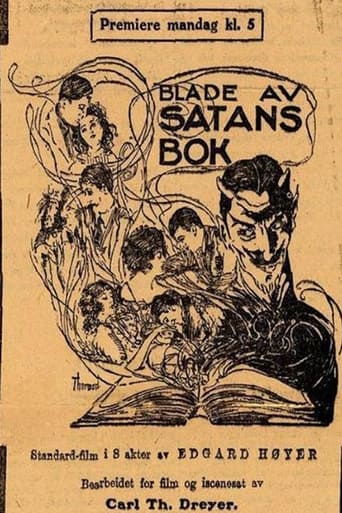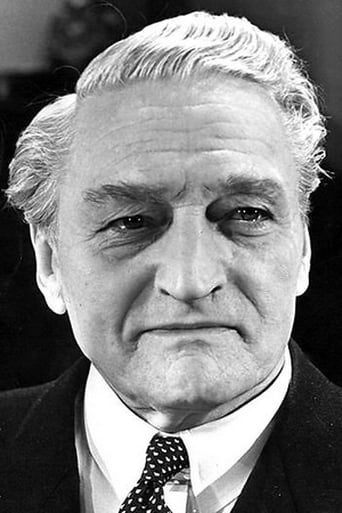

Leaves from Satan's Book (1920)
The power of Satan is highlighted in four historical tales: the betrayal and subsequent arrest of Jesus, the Spanish Inquisition, the French Revolution and the execution of Marie Antoinette, and the Finnish War of Independence in 1918.
Watch Trailer
Cast


Reviews
Captivating movie !
Exactly the movie you think it is, but not the movie you want it to be.
It's easily one of the freshest, sharpest and most enjoyable films of this year.
The film never slows down or bores, plunging from one harrowing sequence to the next.
Leaves from Satan's Book (1922) ** (out of 4) Carl Theodor Dreyer's tale of Satan's attempt to use temptation to get back into Heaven. We follow Satan through four periods including the crucifixion of Jesus and the Spanish Inquisition. The film is visually beautiful and the set design is remarkable but the stories are all deadly boring. The third segment, which is the longest, is downright bad. The first segment with Jesus has way too unintentional laughs and it's rather strange that Jesus looks a lot creepier than Satan!Those expecting a horror film will probably be disappointing as this film plays out more like a historical drama.
Carl Theodor Dreyer's second feature film is an ambitious study of evil through the ages, but the great Danish filmmaker is years away from his masterpieces of The Passion of Joan of Arc, Vampyr, Day of Wrath, Ordet and Gertrud. The inexperienced filmmaker was influenced by D.W. Griffith's 1916 Intolerance and aimed to map out the path of the Devil using Griffith's innovative filming style as a guide. He added on his realistic approach to the subject matter, as he believed realism to be the most essential part of any film.Like its inspiration, Intolerance, Leaves from Satan's Book contains stories from four historical periods linked thematically. Unlike Griffith's film though, Dreyer chose not to cross cut between stories, which makes for a less confusing film.Satan is the character who links the four stories. The film starts with his fall from grace, as told through inter-titles, and God's proclamation that he walk the Earth tempting humanity. For each soul that turns from God, 100 years will be added to Satan's sentence, but for every person who resists his temptations, 1000 years will be removed. Hoping to fail in his duties so that he may be admitted back into heaven, Satan tries to get men to betray what they hold most dear in four eras of history.The first section of the film is the biblical story of Jesus' betrayal by Judas. The next story takes place during the Spanish Inquisition. The third section of the film takes place during the French Revolution. The final segment is set in the Finland during the Russo-Finnish war of 1918. As a film, this wasn't Dreyer's best, but it was fairly entertaining. This early Dreyer film shows his almost innate ability to compose attractive images within the limits of the frame.Though this film isn't the grand spectacle he was hoping for, Dreyer did a wonderful job with it. His use of the film frame and style of story telling make this a movie interesting and attractive to watch.
Had I reviewed this back in 1921, I might have given the film a score of 9 because it was technically very well made. The direction, cinematography and acting are excellent for the era--there are absolutely no complaints there. Unfortunately, today I am only giving it a score of 7 because of this technical merit--otherwise, the film is very dated and hard to watch due to its preachy and heavy-handed plot. It's also a Danish attempt to cash in on D. W. Griffith's INTOLERANCE by making essentially the same film.The film is about three ages of mankind that together prove that mankind stinks and that the Devil is the master of betrayals. The first segment is about the crucifixion of Jesus, the second the Inquisition and the third the Reign of Terror. All these segments look like elaborately staged but soul-less recreations done in a documentary style. Sure, the sets are great, but there is no life to the scenes at all.The Christ segment is interesting because Jesus looks exactly like the very inaccurate traditional paintings of Him. This is pretty cool, but he appears about as Jewish as a polar bear! I was also disappointed because although this part of the film was very close to the Gospels, the part about Peter chopping off one of the soldier's ears wasn't included! The Inquisition segment is interesting because it seems to imply that the young monk who joined the inquisitors raped the woman he loved who was arrested and tried--then she is, apparently, killed! This is highly reminiscent of THE HUNCHBACK OF NOTRE DAME. As for the Reign of Terror segment, it seemed to imply that Louis XVI and Marie Antoinette were innocent victims--an interesting interpretation of history if you ask me!So, if you like to see elaborate recreations of historical events that aren't all that compelling or interesting, then this is your film! Otherwise, there are many, many silent films far worth seeing.
BLADE AF SATANS BOG (titled LEAVES FROM Satan'S BOOK on the DVD cover but LEAVES OUT OF THE BOOK OF Satan on the print) is a lurching silent film epic, running over two hours in length, that hypothesizes Satan's influence on weak-willed men and altering certain historic events. The film is divided into four highly variable sections, all taking place at different time periods, with the impressive Helge Nissen appearing as various guises as Satan in each segment. All are tinted a variety of different colors, from black-and-white to monochrome to lighter hues (blue, green, pink, etc.) and the cinematography, lighting, art direction, costumes and editing are often striking, just not often enough to completely overcome the uneven writing and a very slow pace.The first story is one we're all pretty familiar with - Jesus' betrayal by Judas, with Judas here being influenced by a turbaned and bearded Satan. Familiarity with this biblical tale takes the edge off and best can be said about this segment is in regards to a few moments of clever lighting (the last supper shot as another reviewer mentioned). The second story, set during the Spanish Inquisition, is an improvement. This is also the most horrific of the segments, with scenes set inside a torture chamber and Nissen's heavily-rouged face and intense, sneaky glares instantly bringing to mind Lugosi's classic Dracula character. Here, Satan plays Grand Inquisitor, leading astray a very nubile young love-struck priest who uses self-flagellation to rid his body of sin. One interesting scene features the priest whipping his back while envisioning the object of his desire draped below a cross (a shot I've seen used many times since).The third, and by far best, segment takes place during the French Revolution and opens with a striking shot of a guillotine sitting alone atop a hillside right as the sun is setting. This is also the strongest tale from a narrative standpoint as it cuts back and forth between two separate story lines but brings everything together at the end. A young man named Joseph helps a noblewoman and her daughter flee the city when authorities show up to execute the entire family for aiding the escape of a queen sentenced to death. When Joseph's advances are rejected by the daughter, Satan shows up to convince him to turn his back on both the mother/daughter, and later Marie Antoinette herself. The fourth segment, set in "modern times" (1918!) is about the Russian occupation of Finland and only has moments of occasional interest, both visually and thematically.There are a few memorable performances in this movie. Nissen is truly fascinating as all four visions of Satan; alternately creepy, clever, vengeful and weary. Also worth mentioning are Tenna Frederiksen Kraft, who is a graceful and sympathetic Marie Antoinette, and Elith Pio as Joseph, a man seriously torn between doing the right thing when lives hang in the balance... or just the right thing to advance himself.All in all, it's very slow and very uneven, but worth checking out if you are either a Dreyer completist or into silent pictures. But truth be told, the director has seen much better days; MICHAEL (1924), THE PASSION OF JOAN OF ARC (1928), VAMPYR (1932), VREDEN'S DAG (1943), etc.



